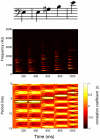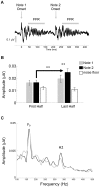Hearing it again and again: on-line subcortical plasticity in humans
- PMID: 21049035
- PMCID: PMC2964325
- DOI: 10.1371/journal.pone.0013645
Hearing it again and again: on-line subcortical plasticity in humans
Abstract
Background: Human brainstem activity is sensitive to local sound statistics, as reflected in an enhanced response in repetitive compared to pseudo-random stimulus conditions [1]. Here we probed the short-term time course of this enhancement using a paradigm that assessed how the local sound statistics (i.e., repetition within a five-note melody) interact with more global statistics (i.e., repetition of the melody).
Methodology/principal findings: To test the hypothesis that subcortical repetition enhancement builds over time, we recorded auditory brainstem responses in young adults to a five-note melody containing a repeated note, and monitored how the response changed over the course of 1.5 hrs. By comparing response amplitudes over time, we found a robust time-dependent enhancement to the locally repeating note that was superimposed on a weaker enhancement of the globally repeating pattern.
Conclusions/significance: We provide the first demonstration of on-line subcortical plasticity in humans. This complements previous findings that experience-dependent subcortical plasticity can occur on a number of time scales, including life-long experiences with music and language, and short-term auditory training. Our results suggest that the incoming stimulus stream is constantly being monitored, even when the stimulus is physically invariant and attention is directed elsewhere, to augment the neural response to the most statistically salient features of the ongoing stimulus stream. These real-time transformations, which may subserve humans' strong disposition for grouping auditory objects, likely reflect a mix of local processes and corticofugal modulation arising from statistical regularities and the influences of expectation. Our results contribute to our understanding of the biological basis of statistical learning and initiate a new investigational approach relating to the time-course of subcortical plasticity. Although the reported time-dependent enhancements are believed to reflect universal neurophysiological processes, future experiments utilizing a larger array of stimuli are needed to establish the generalizability of our findings.
Conflict of interest statement
Figures







Similar articles
-
Stability and plasticity in neural encoding of linguistically relevant pitch patterns.J Neurophysiol. 2017 Mar 1;117(3):1407-1422. doi: 10.1152/jn.00445.2016. Epub 2017 Jan 11. J Neurophysiol. 2017. PMID: 28077662 Free PMC article.
-
Prior experience biases subcortical sensitivity to sound patterns.J Cogn Neurosci. 2015 Jan;27(1):124-40. doi: 10.1162/jocn_a_00691. J Cogn Neurosci. 2015. PMID: 25061926
-
The layering of auditory experiences in driving experience-dependent subcortical plasticity.Hear Res. 2014 May;311:36-48. doi: 10.1016/j.heares.2014.01.002. Epub 2014 Jan 18. Hear Res. 2014. PMID: 24445149 Review.
-
Familiar But Unexpected: Effects of Sound Context Statistics on Auditory Responses in the Songbird Forebrain.J Neurosci. 2017 Dec 6;37(49):12006-12017. doi: 10.1523/JNEUROSCI.5722-12.2017. Epub 2017 Nov 8. J Neurosci. 2017. PMID: 29118103 Free PMC article.
-
An integrative model of subcortical auditory plasticity.Brain Topogr. 2014 Jul;27(4):539-52. doi: 10.1007/s10548-013-0323-9. Epub 2013 Oct 23. Brain Topogr. 2014. PMID: 24150692 Review.
Cited by
-
Neural Encoding of Speech and Music: Implications for Hearing Speech in Noise.Semin Hear. 2011 May 1;32(2):129-141. doi: 10.1055/s-0031-1277234. Semin Hear. 2011. PMID: 24748717 Free PMC article.
-
The cortical modulation of stimulus-specific adaptation in the auditory midbrain and thalamus: a potential neuronal correlate for predictive coding.Front Syst Neurosci. 2015 Mar 9;9:19. doi: 10.3389/fnsys.2015.00019. eCollection 2015. Front Syst Neurosci. 2015. PMID: 25805974 Free PMC article. Review.
-
Selective attention modulates human auditory brainstem responses: relative contributions of frequency and spatial cues.PLoS One. 2014 Jan 15;9(1):e85442. doi: 10.1371/journal.pone.0085442. eCollection 2014. PLoS One. 2014. PMID: 24454869 Free PMC article.
-
Free-Field Cortical Steady-State Evoked Potentials in Cochlear Implant Users.Brain Topogr. 2021 Sep;34(5):664-680. doi: 10.1007/s10548-021-00860-2. Epub 2021 Jun 29. Brain Topogr. 2021. PMID: 34185222
-
Adaptation in the auditory system: an overview.Front Integr Neurosci. 2014 Feb 21;8:19. doi: 10.3389/fnint.2014.00019. eCollection 2014. Front Integr Neurosci. 2014. PMID: 24600361 Free PMC article. Review.
References
-
- Large E, Jones M. The dynamics of attending: How people track time-varying events. Psychol Rev. 1999;106:119–159.
-
- Saffran JR. Musical learning and language development. Ann N Y Acad Sci. 2003;999:397–401. - PubMed
-
- Winkler I, Denham SL, Nelken I. Modeling the auditory scene: predictive regularity representations and perceptual objects. Trends Cogn Sci. 2009;13:532–540. - PubMed
-
- Drake C, Bertrand D. The quest for universals in temporal processing in music. Ann N Y Acad Sci. 2001;930:17–27. - PubMed
Publication types
MeSH terms
Grants and funding
LinkOut - more resources
Full Text Sources

